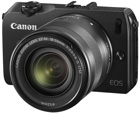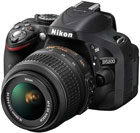Canon EOS M vs Nikon D5200
This is a full comparison between the cameras Canon EOS M and Nikon D5200. We compare them by looking at the categories you see below.
Manufacturing
Canon EOS M is manufacturered by Canon but Nikon D5200 is from Nikon. Both Canon and Nikon are well known brands though.
These two camera models were both released 2012.| Camera | Released |
| Canon EOS M | 2012 |
| Nikon D5200 | 2012 |
Type of camera
Canon EOS M is a Mirrorless camera while Nikon D5200 is a DSLR camera. More information about their differences will come soon.
Sensors / crop factor
These cameras have different sensors. Canon EOS M has a "Canon APS-C"-sensor while Nikon D5200 has a "Nikon DX"-sensor, and their difference in sensors will also affect the crop factor and experience focal length. See the table below.
| Camera | Focal length, 50mm f/1.8 ** |
| Canon EOS M | 80 mm Canon APS-C sensor Crop factor/focal length multiplier by * 1.6 |
| Nikon D5200 | 75 mm Nikon DX sensor Crop factor/focal length multiplier by * 1.5 |
** Experienced focal length when using a lens such as a common "50mm f/1.8"
Learn more about crop factor and focal length multiplier here:
Camera selection can affect the focal length (Canon)
Camera selection can affect the focal length (Nikon)
Resolution
Canon EOS M has a 18 MP (Megapixels) resolution while Nikon D5200 has 24 MP. If we break down this in more detail this is the data behind the numbers:
| Camera | Megapixels |
| Canon EOS M |
18 MP
17915904 pixels 5184 x 3456 |
| Nikon D5200 |
24 MP
24000000 pixels 6000 x 4000 |
Nikon D5200 has a 34 % larger resolution than Canon EOS M. This could give you more details in the picture but also a possibility to crop more in the pictures, afterward while editing the pictures, if needed that is.
ISO range
Canon EOS M has a larger ISO-range than Nikon D5200. Canon EOS M has an ISO range that stretches from 100 to 12800 while Nikon D5200 has 100 to 6400.
| Camera | ISO Range |
| Canon EOS M | 100-12800 |
| Nikon D5200 | 100-6400 |
Autofocus and lens compatibility
There is a big difference between these two cameras. Canon EOS M has a built-in autofocus motor but Nikon D5200 does not. If you want to be able to use autofocus on Nikon D5200 there is a need for having an autofocus motor inside the lens. We really encourage you to look closely at our lens compatibility charts at the links below.
Worth mentioning is that Canon EOS M belongs to the Canon EOS M-system and needs an adapter to work with Canons EF, EF-S, MP-E, and TS-E lenses. You can read more about this adapter here:
Canon Lens Mount Adapter EF-EOS M
Here is a complete overview of which lenses work with each camera:
Lens compatibility chart for Canon EOS M
Lens compatibility chart for Nikon D5200
Pictures per second
Depending on what you are shooting the FPS, or frames/pictures per second, can definitely be of interest. Canon EOS M can shoot up to 4,3 pictures per seconds and Nikon D5200 can shoot up to 5 pictures per seconds.
| Camera | FPS (Frames per second) |
| Canon EOS M | 4,3 |
| Nikon D5200 | 5 |
Ability to record movies
It is becoming more and more popular to record movies with digital cameras.
In this case, both Canon EOS M and Nikon D5200 can shoot movies.
Weight
The weight of the camera can be an extremely important factor, especially if the camera is about to be used, or carried around, for several hours at a time.
Nikon D5200 weighs 555 gr (equal to 1.22 lb) which is 86% heavier than Canon EOS M and its 298 gr (or 0.66 lb).
| Camera | Weight |
| Canon EOS M | 298 gr 0.66 lb |
| Nikon D5200 | 555 gr 1.22 lb |
Canon EOS M vs Nikon D5200 Specs
Below you will find the complete and detailed technical specs for both Canon EOS M and Nikon D5200, next to each other. Each category of data is a link to an article covering the subject, giving you a deeper understanding so you can better understand the strengths and weaknesses of the two camera models.
Product |
Canon EOS M |
Nikon D5200 |
| Name | Canon EOS M | Nikon D5200 |
| Manufacturer | Canon | Nikon |
Release Date and Price |
Canon EOS M |
Nikon D5200 |
| Release Year | 2012 | 2012 |
| Release Date | 2012-07-23 | 2012-11-06 |
| MSRP | 799 USD | 799 USD |
| Buy it today |

|

|
Camera Type |
Canon EOS M |
Nikon D5200 |
| Camera Type | Mirrorless | DSLR |
Sensor |
Canon EOS M |
Nikon D5200 |
| Sensor Size | APS-C (approx 22.3 x 14.9 mm) |
APS-C (approx 23.7 x 15.5 mm) Also known as "DX" |
| Sensor Type | CMOS | CMOS |
| Resolution | 5184 x 3456 pixels | 6000 x 4000 pixels |
| Megapixels | 18 MP | 24 MP |
| Image Processor | DIGIC 5 | EXPEED 3 |
Image |
Canon EOS M |
Nikon D5200 |
| ISO Range | 100 - 12800 | 100 - 6400 |
| White Balance Presets | 6 | 12 |
| Custom White Balance | Yes | Yes |
| Image Stabilization | No | No |
| Image Stabilization CIPA Rating | 0 stops | 0 stops |
| Uncompressed format | RAW | RAW |
Optics & Focus |
Canon EOS M |
Nikon D5200 |
| Autofocus Motor | Yes | No |
| Autofocus |
Contract Detect (sensor) Phase Detect Multi Area Selective Single Point Single Continuous Face Detection LiveView |
Contract Detect (sensor) Phase Detect Multi Area Selective Single Point Tracking Single Continuous Face Detection LiveView |
| Focus Points | 31 | 39 |
| Lens Mount |
Canon EF-M See Compatible Lenses |
Nikon F See Compatible Lenses |
| Focal Length Multiplier |
APS-C Sensor 1.6x multiplier Example: 24 mm becomes 38 mm 50 mm becomes 80 mm 100 mm becomes 160 mm 200 mm becomes 320 mm |
DX / APS-C (1.5x) 1.5x multiplier Example: 24 mm becomes 36 mm 50 mm becomes 75 mm 100 mm becomes 150 mm 200 mm becomes 300 mm |
Screen & Viewfinder |
Canon EOS M |
Nikon D5200 |
| Articulated LCD | Fixed | Fully articulated |
| Screen size | 3” | 3” |
| Screen dots | 1040000 | 921 |
| Touch screen | Yes | No |
| Screen type | Clear View II TFT LCD | TFT LCD monitor |
| Live view | Yes | Yes |
| Viewfinder Type | No Viewfinder | Optical (pentamirror) |
| Viewfinder Coverage | 95% | |
| Viewfinder Magnification | 0.78× (0.52× 35mm equiv.) | |
| Viewfinder Resolution | 0 | N/A |
Photography features |
Canon EOS M |
Nikon D5200 |
| Frames per second | 4,3 fps | 5 fps |
| Minimum Shutter Speed | 60 seconds | 30 seconds |
| Maximum Shutter Speed | 1/4000 seconds | 1/4000 seconds |
| Built-in Flash | No | Yes |
| Built-in Flash Range | N/A | 12 meters |
| External Flash | Yes | Yes |
| Self-Timer | Yes | Yes |
| Time-lapse | No | Yes |
| Metering modes |
Multi Center Weighted Spot Partial |
Multi Center Weighted Spot |
| Exposure Compensation | +/- 3 (at 1/3 EV, 1/2 EV steps) | +/- 5 (at 1/3 EV, 1/2 EV steps) |
Videography features |
Canon EOS M |
Nikon D5200 |
| Video recording | Yes | Yes |
| Video format |
MPEG4 H.264 |
MPEG4 H.264 |
| Video resolution |
1280 x 720 1920 x 1080 |
1280 x 720 1920 x 1080 |
| Built-in Microphone | Yes | Yes |
| Built-in Speakers | Yes | Yes |
Storage |
Canon EOS M |
Nikon D5200 |
| Memory Card |
SD/SDHC |
SD/SDHC |
Connectivity |
Canon EOS M |
Nikon D5200 |
| HDMI Output | Yes | Yes |
| Microphone Port | No | Yes |
| Headphone Port | No | No |
| Wireless |
Yes Eye-Fi Connected |
Yes Optional |
| Remote Control | No |
Yes (Optional ML-L3 or WR-R10)

|
| GPS |
Yes Optional via GP-E2 
|
Yes Optional 
|
Body & Dimensions |
Canon EOS M |
Nikon D5200 |
| Enviromentally sealed | No | No |
| Battery | Battery Pack | Battery Pack |
| Battery Details |
Lithium-Ion LP-E12 rechargeable battery & charger

|
Lithium-Ion EN-EL14 rechargeable battery & charger

|
| Battery Life (CIPA) | 230 shots | 500 shots |
| Width | 109 mm | 129 mm |
| Height | 66 mm | 98 mm |
| Depth | 32 mm | 78 mm |
| Weight | 298 gram | 555 gram |

